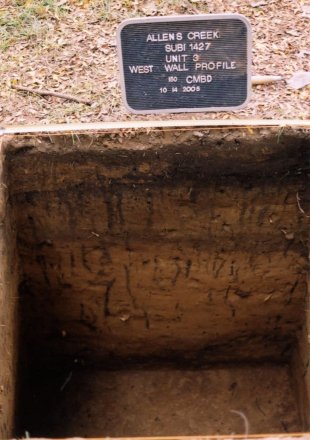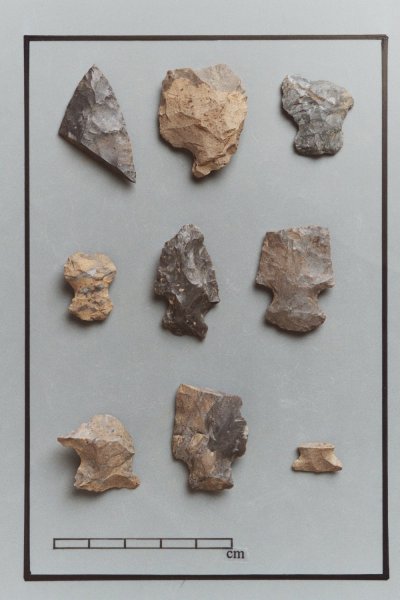Archaeologists used soil stratigraphy, diagnostic projectile points, and radiocarbon dates obtained on charred material recovered from features to reconstruct the cultural layers and chronology for the Allen's Creek site.
Site stratigraphy was complex and showed deep cultural layers. The complete excavated profile contained three A horizons (organic soils indicative of stable surfaces) with B horizons (flood and wind deposited soils) in-between. The first horizons (A1, B1) are mixed contexts with both precontact and historic artifacts and historic fill. A Genesee point recovered from the weak B1 horizon separating the two upper A horizons (A1 and A2) suggests an occupation near the end of the Late Archaic (1800-1500 B.C.). Not much is known of this component since most excavations occurred beneath the surface of NY 36 and contained truncated stratigraphy. Additionally, crews did not find intact features in these upper layers to provide material for radiocarbon dating.
The next horizon, A2, also produced a mix of precontact and historic artifacts, but with a much smaller number of historic artifacts. No diagnostic precontact artifacts were recovered from the A2 horizon. However, cultural features identified in the upper portions of the horizon below, the B2, probably originated within the A2 horizon soils. The B2 horizon (and associated features) includes Late Archaic projectile points (Brewerton, Lamoka, Dustin, Vestal-like, Genesee, Snook Kill, and untyped stemmed and side-notched). Radiocarbon dates from B2 horizon features span a period of nearly 2,000 years (3360-1120 B.C.). The B2 horizon contained the majority of intact precontact artifacts and features at the site.


The A3 horizon underneath the B2 is the last cultural layer. This horizon produced a light concentration of precontact artifacts and a small charcoal feature dated to the Late Archaic period. The final horizon excavated is the B3 horizon. The B3 horizon represents a culturally sterile B horizon underlying the A3 horizon.
Archaeologists obtained accelerator mass spectrometry (AMS) dates on nutshell from nine features. The AMS dates correspond with the date range suggested by the diagnostic projectile points, with a two sigma date range of 3360-1120 B.C., spanning the Late Archaic and part of the Transitional period. The four features (2, 4, 6, and 20) located entirely within the B2 horizon date consistently within the Brewerton phase of the Late Archaic with two sigma AMS dates ranging from 3360-2880 B.C. (Beta-228625, Beta-228626, Beta-228627, Beta-228631, respectively). Features associated with the horizon above the B2 (fill/B2 horizon and Features 7, 16, and 22) produced AMS dates ranging from 2280-1530 B.C. (Beta-228628, Beta-228629, Beta-228632, respectively), suggesting an occupation ranging from the Lamoka component of the Narrow Stemmed Point Tradition to the Broad Point Tradition of the Transitional period. A single feature (Feature 19) produced a two sigma date range of 1380-1120 B.C., placing it within the Transitional period (Beta-228630). One date, on nutshell recovered from Feature 1 (A3 horizon, deepest cultural horizon at the site), appears suspect. The two sigma date range of 2480-2220 B.C. (Beta-228898) is younger than many of the dates produced by features located above it in the stratigraphic sequence. This, coupled with the presence of uncharred plant remains in the feature, suggests that the date for Feature 1 is unreliable.
In summary, it is apparent that the location of the Allen's Creek site was attractive to Native groups throughout the Late Archaic and to a small degree into the subsequent Transitional period. The site was repeatedly visited by hunter/gatherer groups from approximately 3500-1100 B.C. Stratified components include: one associated with the B1 horizon with a single diagnostic artifact (Genesee point); one associated with the upper A horizon (fill/B2) with features dating from 2280-1120 B.C. and diagnostic lithics spanning Lamoka Narrow Stemmed to Genesee/Snook Kill Broad Point Traditions; and one, associated with the B2 horizon, dates to the Brewerton phase (3500-2500 B.C.) with AMS dates ranging from 3360-2880 B.C. and diagnostic artifacts that include Brewerton, Lamoka, and Vestal-like projectile points. Finally, the earliest (deepest) layer of site use (A3 horizon) is undated.